Shuyan Zhou
EnvInjection: Environmental Prompt Injection Attack to Multi-modal Web Agents
May 16, 2025Abstract:Multi-modal large language model (MLLM)-based web agents interact with webpage environments by generating actions based on screenshots of the webpages. Environmental prompt injection attacks manipulate the environment to induce the web agent to perform a specific, attacker-chosen action--referred to as the target action. However, existing attacks suffer from limited effectiveness or stealthiness, or are impractical in real-world settings. In this work, we propose EnvInjection, a new attack that addresses these limitations. Our attack adds a perturbation to the raw pixel values of the rendered webpage, which can be implemented by modifying the webpage's source code. After these perturbed pixels are mapped into a screenshot, the perturbation induces the web agent to perform the target action. We formulate the task of finding the perturbation as an optimization problem. A key challenge in solving this problem is that the mapping between raw pixel values and screenshot is non-differentiable, making it difficult to backpropagate gradients to the perturbation. To overcome this, we train a neural network to approximate the mapping and apply projected gradient descent to solve the reformulated optimization problem. Extensive evaluation on multiple webpage datasets shows that EnvInjection is highly effective and significantly outperforms existing baselines.
CowPilot: A Framework for Autonomous and Human-Agent Collaborative Web Navigation
Jan 28, 2025



Abstract:While much work on web agents emphasizes the promise of autonomously performing tasks on behalf of users, in reality, agents often fall short on complex tasks in real-world contexts and modeling user preference. This presents an opportunity for humans to collaborate with the agent and leverage the agent's capabilities effectively. We propose CowPilot, a framework supporting autonomous as well as human-agent collaborative web navigation, and evaluation across task success and task efficiency. CowPilot reduces the number of steps humans need to perform by allowing agents to propose next steps, while users are able to pause, reject, or take alternative actions. During execution, users can interleave their actions with the agent by overriding suggestions or resuming agent control when needed. We conducted case studies on five common websites and found that the human-agent collaborative mode achieves the highest success rate of 95% while requiring humans to perform only 15.2% of the total steps. Even with human interventions during task execution, the agent successfully drives up to half of task success on its own. CowPilot can serve as a useful tool for data collection and agent evaluation across websites, which we believe will enable research in how users and agents can work together. Video demonstrations are available at https://oaishi.github.io/cowpilot.html
TheAgentCompany: Benchmarking LLM Agents on Consequential Real World Tasks
Dec 18, 2024Abstract:We interact with computers on an everyday basis, be it in everyday life or work, and many aspects of work can be done entirely with access to a computer and the Internet. At the same time, thanks to improvements in large language models (LLMs), there has also been a rapid development in AI agents that interact with and affect change in their surrounding environments. But how performant are AI agents at helping to accelerate or even autonomously perform work-related tasks? The answer to this question has important implications for both industry looking to adopt AI into their workflows, and for economic policy to understand the effects that adoption of AI may have on the labor market. To measure the progress of these LLM agents' performance on performing real-world professional tasks, in this paper, we introduce TheAgentCompany, an extensible benchmark for evaluating AI agents that interact with the world in similar ways to those of a digital worker: by browsing the Web, writing code, running programs, and communicating with other coworkers. We build a self-contained environment with internal web sites and data that mimics a small software company environment, and create a variety of tasks that may be performed by workers in such a company. We test baseline agents powered by both closed API-based and open-weights language models (LMs), and find that with the most competitive agent, 24% of the tasks can be completed autonomously. This paints a nuanced picture on task automation with LM agents -- in a setting simulating a real workplace, a good portion of simpler tasks could be solved autonomously, but more difficult long-horizon tasks are still beyond the reach of current systems.
Beyond Browsing: API-Based Web Agents
Oct 21, 2024



Abstract:Web browsers are a portal to the internet, where much of human activity is undertaken. Thus, there has been significant research work in AI agents that interact with the internet through web browsing. However, there is also another interface designed specifically for machine interaction with online content: application programming interfaces (APIs). In this paper we ask -- what if we were to take tasks traditionally tackled by browsing agents, and give AI agents access to APIs? To do so, we propose two varieties of agents: (1) an API-calling agent that attempts to perform online tasks through APIs only, similar to traditional coding agents, and (2) a Hybrid Agent that can interact with online data through both web browsing and APIs. In experiments on WebArena, a widely-used and realistic benchmark for web navigation tasks, we find that API-based agents outperform web browsing agents. Hybrid Agents out-perform both others nearly uniformly across tasks, resulting in a more than 20.0% absolute improvement over web browsing alone, achieving a success rate of 35.8%, achiving the SOTA performance among task-agnostic agents. These results strongly suggest that when APIs are available, they present an attractive alternative to relying on web browsing alone.
WebCanvas: Benchmarking Web Agents in Online Environments
Jun 18, 2024Abstract:For web agents to be practically useful, they must adapt to the continuously evolving web environment characterized by frequent updates to user interfaces and content. However, most existing benchmarks only capture the static aspects of the web. To bridge this gap, we introduce WebCanvas, an innovative online evaluation framework for web agents that effectively addresses the dynamic nature of web interactions. WebCanvas contains three main components to facilitate realistic assessments: (1) A novel evaluation metric which reliably capture critical intermediate actions or states necessary for task completions while disregarding noise caused by insignificant events or changed web-elements. (2) A benchmark dataset called Mind2Web-Live, a refined version of original Mind2Web static dataset containing 542 tasks with 2439 intermediate evaluation states; (3) Lightweight and generalizable annotation tools and testing pipelines that enables the community to collect and maintain the high-quality, up-to-date dataset. Building on WebCanvas, we open-source an agent framework with extensible modules for reasoning, providing a foundation for the community to conduct online inference and evaluations. Our best-performing agent achieves a task success rate of 23.1% and a task completion rate of 48.8% on the Mind2Web-Live test set. Additionally, we analyze the performance discrepancies across various websites, domains, and experimental environments. We encourage the community to contribute further insights on online agent evaluation, thereby advancing this field of research.
OSWorld: Benchmarking Multimodal Agents for Open-Ended Tasks in Real Computer Environments
Apr 11, 2024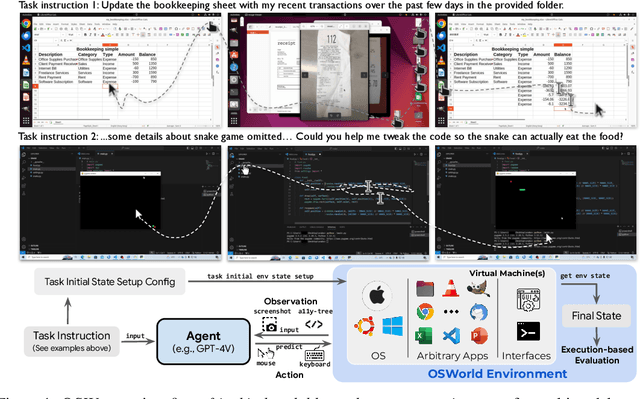
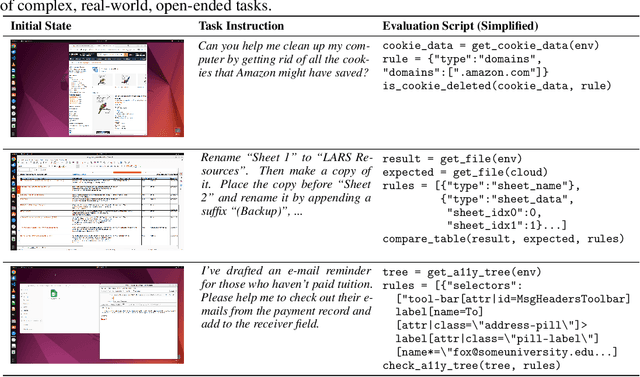
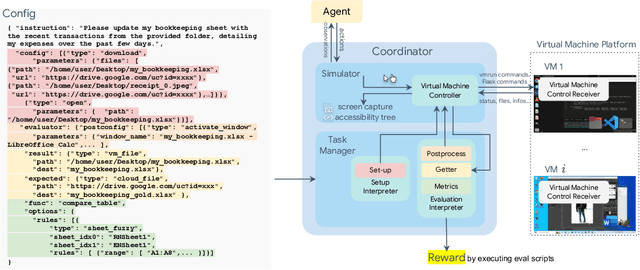
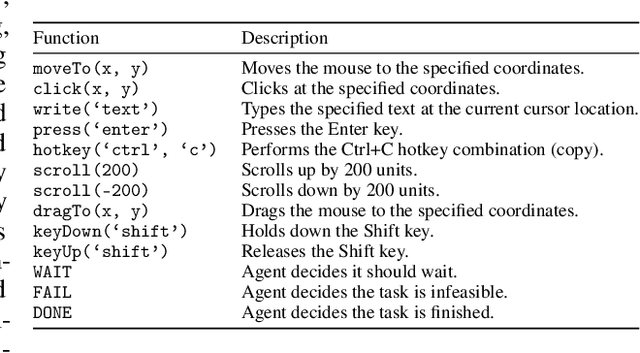
Abstract:Autonomous agents that accomplish complex computer tasks with minimal human interventions have the potential to transform human-computer interaction, significantly enhancing accessibility and productivity. However, existing benchmarks either lack an interactive environment or are limited to environments specific to certain applications or domains, failing to reflect the diverse and complex nature of real-world computer use, thereby limiting the scope of tasks and agent scalability. To address this issue, we introduce OSWorld, the first-of-its-kind scalable, real computer environment for multimodal agents, supporting task setup, execution-based evaluation, and interactive learning across various operating systems such as Ubuntu, Windows, and macOS. OSWorld can serve as a unified, integrated computer environment for assessing open-ended computer tasks that involve arbitrary applications. Building upon OSWorld, we create a benchmark of 369 computer tasks involving real web and desktop apps in open domains, OS file I/O, and workflows spanning multiple applications. Each task example is derived from real-world computer use cases and includes a detailed initial state setup configuration and a custom execution-based evaluation script for reliable, reproducible evaluation. Extensive evaluation of state-of-the-art LLM/VLM-based agents on OSWorld reveals significant deficiencies in their ability to serve as computer assistants. While humans can accomplish over 72.36% of the tasks, the best model achieves only 12.24% success, primarily struggling with GUI grounding and operational knowledge. Comprehensive analysis using OSWorld provides valuable insights for developing multimodal generalist agents that were not possible with previous benchmarks. Our code, environment, baseline models, and data are publicly available at https://os-world.github.io.
VisualWebArena: Evaluating Multimodal Agents on Realistic Visual Web Tasks
Jan 24, 2024
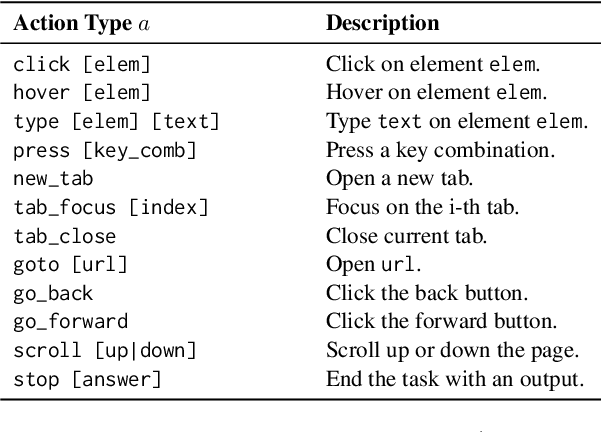


Abstract:Autonomous agents capable of planning, reasoning, and executing actions on the web offer a promising avenue for automating computer tasks. However, the majority of existing benchmarks primarily focus on text-based agents, neglecting many natural tasks that require visual information to effectively solve. Given that most computer interfaces cater to human perception, visual information often augments textual data in ways that text-only models struggle to harness effectively. To bridge this gap, we introduce VisualWebArena, a benchmark designed to assess the performance of multimodal web agents on realistic \textit{visually grounded tasks}. VisualWebArena comprises of a set of diverse and complex web-based tasks that evaluate various capabilities of autonomous multimodal agents. To perform on this benchmark, agents need to accurately process image-text inputs, interpret natural language instructions, and execute actions on websites to accomplish user-defined objectives. We conduct an extensive evaluation of state-of-the-art LLM-based autonomous agents, including several multimodal models. Through extensive quantitative and qualitative analysis, we identify several limitations of text-only LLM agents, and reveal gaps in the capabilities of state-of-the-art multimodal language agents. VisualWebArena provides a framework for evaluating multimodal autonomous language agents, and offers insights towards building stronger autonomous agents for the web. Our code, baseline models, and data is publicly available at https://jykoh.com/vwa.
WebArena: A Realistic Web Environment for Building Autonomous Agents
Jul 25, 2023



Abstract:With generative AI advances, the exciting potential for autonomous agents to manage daily tasks via natural language commands has emerged. However, cur rent agents are primarily created and tested in simplified synthetic environments, substantially limiting real-world scenario representation. In this paper, we build an environment for agent command and control that is highly realistic and reproducible. Specifically, we focus on agents that perform tasks on websites, and we create an environment with fully functional websites from four common domains: e-commerce, social forum discussions, collaborative software development, and content management. Our environment is enriched with tools (e.g., a map) and external knowledge bases (e.g., user manuals) to encourage human-like task-solving. Building upon our environment, we release a set of benchmark tasks focusing on evaluating the functional correctness of task completions. The tasks in our benchmark are diverse, long-horizon, and are designed to emulate tasks that humans routinely perform on the internet. We design and implement several autonomous agents, integrating recent techniques such as reasoning before acting. The results demonstrate that solving complex tasks is challenging: our best GPT-4-based agent only achieves an end-to-end task success rate of 10.59%. These results highlight the need for further development of robust agents, that current state-of-the-art LMs are far from perfect performance in these real-life tasks, and that WebArena can be used to measure such progress. Our code, data, environment reproduction resources, and video demonstrations are publicly available at https://webarena.dev/.
Hierarchical Prompting Assists Large Language Model on Web Navigation
May 23, 2023Abstract:Large language models (LLMs) struggle on processing complicated observations in interactive decision making. To alleviate this issue, we propose a simple hierarchical prompting approach. Diverging from previous prompting approaches that always put the \emph{full} observation~(\eg a web page) to the prompt, we propose to first construct an action-aware observation which is more \emph{condensed} and \emph{relevant} with a dedicated \summ prompt. The \actor prompt then predicts the next action based on the summarized history. While our method has broad applicability, we particularly demonstrate its efficacy in the complex domain of web navigation where a full observation often contains redundant and irrelevant information. Our approach outperforms the previous state-of-the-art prompting mechanism with the same LLM by 6.2\% on task success rate, demonstrating its potential on interactive decision making tasks with long observation traces.
Bridging the Gap: A Survey on Integrating Feedback for Natural Language Generation
May 01, 2023


Abstract:Many recent advances in natural language generation have been fueled by training large language models on internet-scale data. However, this paradigm can lead to models that generate toxic, inaccurate, and unhelpful content, and automatic evaluation metrics often fail to identify these behaviors. As models become more capable, human feedback is an invaluable signal for evaluating and improving models. This survey aims to provide an overview of the recent research that has leveraged human feedback to improve natural language generation. First, we introduce an encompassing formalization of feedback, and identify and organize existing research into a taxonomy following this formalization. Next, we discuss how feedback can be described by its format and objective, and cover the two approaches proposed to use feedback (either for training or decoding): directly using the feedback or training feedback models. We also discuss existing datasets for human-feedback data collection, and concerns surrounding feedback collection. Finally, we provide an overview of the nascent field of AI feedback, which exploits large language models to make judgments based on a set of principles and minimize the need for human intervention.
 Add to Chrome
Add to Chrome Add to Firefox
Add to Firefox Add to Edge
Add to Edge